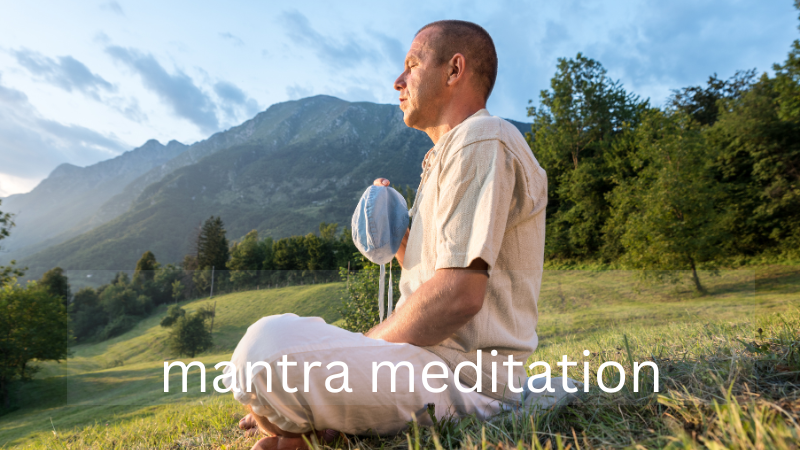What is Mantra Meditation?
Mantra meditation is an ancient technique where the repetition of a particular mantra helps the practitioner achieve a state of mental calm and focus. During this meditation, a specific sound or phrase is chanted repeatedly, allowing the mind to reach deeper levels of concentration.
Importance of Mantra Meditation
Mantra meditation can effectively reduce mental stress, bringing peace to the mind and balance to the body. It provides a powerful means of connecting with inner tranquility and grounding oneself.
Types of Mantra Meditation
Bija Mantra Meditation
Bija mantras like "Om," "Hreem," and "Kleem" are single-syllable sounds that hold significant spiritual power. Practicing Bija mantra meditation is believed to channel energy within the body and mind.
Vedic Mantra Meditation
In Vedic mantra meditation, Sanskrit mantras such as the "Gayatri Mantra" are chanted. This meditation is particularly beneficial for spiritual development and enhancing one's inner awareness.
Choosing the Right Time for Meditation
Early morning and sunset are considered ideal times for mantra meditation. During these hours, the environment is usually peaceful, making meditation more effective and deeply rejuvenating.
How to Select Your Mantra?
Selecting the right mantra is crucial for effective meditation. Generally, Bija mantras or Vedic mantras are chosen according to one’s personal needs, goals, and spiritual alignment. Consulting with an experienced meditation teacher can be helpful in making the right choice.
Benefits of Mantra Meditation
Mantra meditation offers numerous benefits, such as:
- Mental Clarity: Helps clear mental fog and sharpens focus.
- Reduced Stress: Calms the nervous system, lowering stress levels.
- Emotional Balance: Promotes a sense of inner harmony and emotional stability.
- Improved Concentration: Enhances the ability to concentrate for longer periods.
Simple Steps to Practice Mantra Meditation
- Find a Quiet Place: Choose a calm environment where you won’t be disturbed.
- Sit Comfortably: Position yourself in a comfortable seated posture.
- Choose Your Mantra: Decide on the mantra you’ll be repeating.
- Begin the Repetition: Slowly repeat the mantra, focusing on the sound and rhythm.
- Deep Breathing: Take slow, deep breaths to align your focus with the mantra.
- Conclude Gently: Slowly bring your meditation to a close when you feel ready.
Tips for Beginners in Mantra Meditation
- Start Small: Begin with a few minutes daily and gradually increase your practice time.
- Set a Routine: Try to meditate at the same time each day to build consistency.
- Be Patient: Remember, results take time and patience.
How to Focus During Mantra Meditation?
Focus on the sound of your mantra and try to visualize its meaning. This helps prevent the mind from wandering and keeps you grounded in the meditation experience.
Common Obstacles in Meditation
It’s natural to face obstacles like racing thoughts, physical discomfort, or even impatience during meditation. Over time, these barriers diminish as you build greater focus and resilience through regular practice.
Mantra Meditation vs. Other Meditation Techniques
Unlike mindfulness meditation that focuses on the breath or observation, mantra meditation involves the active repetition of a sound. This vocal repetition can be particularly effective for individuals who find silence challenging.
Significance of Experiences During Meditation
During meditation, you may experience various thoughts, emotions, or even visuals. These are normal and are part of the mind's release process. Observing without attachment can help deepen your practice.
Mantra Meditation and Mental Peace
Regular mantra meditation can create a lasting sense of mental peace and emotional well-being. This mental calmness often extends beyond meditation sessions, improving your overall quality of life.
How to Incorporate Mantra Meditation into Daily Routine?
Incorporate mantra meditation by setting aside a specific time each day, such as after waking up or before going to bed. Consistency helps make meditation an integral part of your routine.
Conclusion and Commitment to Meditation
Mantra meditation offers a pathway to inner peace and mental clarity. By committing to regular practice, you can unlock profound benefits that enrich both your personal and spiritual life.
FAQs About Mantra Meditation
1. How long should I practice mantra meditation daily?
For beginners, starting with 5-10 minutes daily is ideal. As you become more comfortable, you can gradually increase your practice to 20-30 minutes or longer, depending on your preference and schedule.
2. Can I use any word or phrase as a mantra?
While you can technically use any word, certain Sanskrit mantras like “Om” or “Shanti” have been traditionally used for their spiritual power. However, a meaningful word or phrase that resonates with you personally can also be effective.
3. Do I need a teacher to learn mantra meditation?
Although having a teacher can be helpful, many people successfully learn and practice mantra meditation on their own with the help of books, online resources, and meditation apps.
4. What should I do if my mind wanders during meditation?
It’s normal for the mind to wander. Simply bring your attention back to the mantra whenever you notice your thoughts drifting. Over time, you’ll find it easier to stay focused.
5. Can mantra meditation help with stress and anxiety?
Yes, mantra meditation is known for its calming effects on the mind, which can reduce stress and anxiety. Regular practice has been shown to improve emotional resilience and overall mental health.





Comments